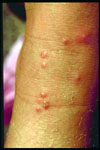You can tell you have fire ants if…
 You see a mound of fluffy worked soil, particularly a few days after a heavy rain.
You see a mound of fluffy worked soil, particularly a few days after a heavy rain.
The mound has no opening in the center like most ant mounds.Red imported fire ants leave and enter the mound housing the colony through underground tunnels.
 Undisturbed mounds in pastures can reach 18 inches in height, but most mounds in turfgrass areas are usually just a few inches tall. When you shovel into the colony’s mound of soil you see white objects. This is the brood – the eggs, larvae and pupae of developing ants.
Undisturbed mounds in pastures can reach 18 inches in height, but most mounds in turfgrass areas are usually just a few inches tall. When you shovel into the colony’s mound of soil you see white objects. This is the brood – the eggs, larvae and pupae of developing ants.
 Fire ants are small, only about 1/8″ to 1/4″ long. Variation in size is a distinguishing characteristic of imported fire ants. Many other ant species are uniform in size.
Fire ants are small, only about 1/8″ to 1/4″ long. Variation in size is a distinguishing characteristic of imported fire ants. Many other ant species are uniform in size.
When you disturb the mound, dozens to hundreds of reddish-brown worker ants crawl up vertical surfaces (like grasses and other objects) on and around the mound. Few native ants charge up vertical surfaces.
 If you get stung it feels like being burned. A day or so later, the imported fire ant’s unique venom forms a white fluid filled pustule or blister at the red sting site that is very characteristic – only fire ant venom causes this symptom!
If you get stung it feels like being burned. A day or so later, the imported fire ant’s unique venom forms a white fluid filled pustule or blister at the red sting site that is very characteristic – only fire ant venom causes this symptom!
Worker ants bite (with mandibles) and sting (with stingers) aggressively and repeatedly.
For more information:
Ant Facts
Fact Sheets and Publications about fire ants
Protect Against Deadly Fire Ant Stings
